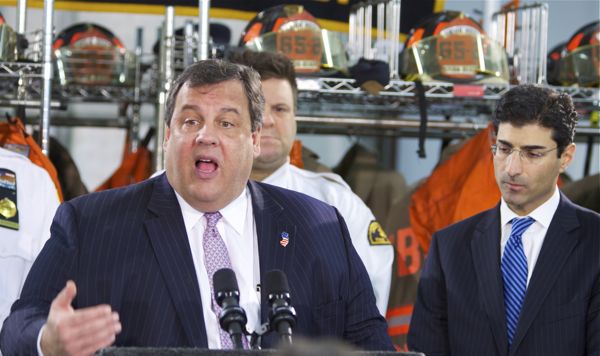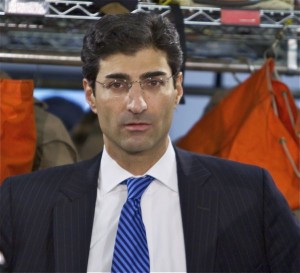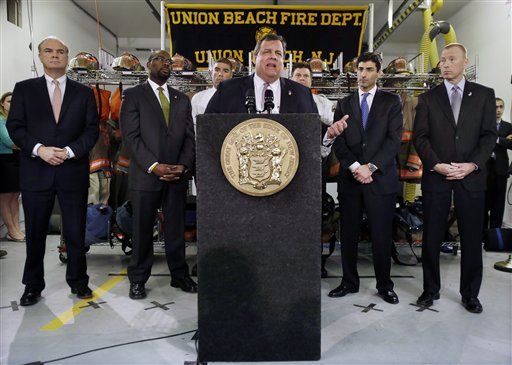Pinelands Commission Staff Presents Controversial Gas Pipeline Plan
Plan Was Quietly Under Review Since April 2012 – Nature of Review Process Suggests “Agency Capture”
[Updates below in text]
An overflow crowd spilled outside the packed hearing room today, as Pinelands staff presented the controversial South Jersey Gas Co. natural gas pipeline through the Pinelands to re-power the BL England coal/oil power plant at Beesley’s Point. I will provide a link to that presentation when it’s posted on Commission website (here it is).
The presentation was to the Policy and Implementation Committee – the proposed project is not yet before the full Commission for formal review. Accordingly, there is still time to make changes to improve the review process, as I suggested today (see below).
Staff outlined the review process to date, provided a brief overview of the project and its impacts, and described its current status.
The staff briefing said nothing about future review plans going forward, a critical omission.
The project has been designated an “inconsistent certificate of filing” because it conflicts with the Pinelands Comprehensive Management Plan (CMP) and regulations.
Curiously, while staff did not present the going forward review options for such an “inconsistent” project, I assume that there are two options at this point: a) denial; or b) approval via a “Memorandum of Agreement” (MOA) based upon a finding of “equivalent” protection.
The term “equivalence” is bureaucratic regulatory code for a dirty deal.
As I’ve suggested, the project – politically – is a done deal.
It has the support of the Governor – BPU bluntly emphasized that the project was approved because it implemented Gov. Christie’s Energy master Plan. The project has received all other permits and approvals (all made with little public input). The Commission is last in line and under enormous political pressure to approve the project. The project can not proceed without Commission approval.
There are no regulatory standards, scientific methods, or technical criteria or methods to define, measure, or determine what an “equivalent level of protection” is, so there is enormous – virtually unconfined – discretion by the staff and Commission in making this call.
The existence of unconfined discretion, coupled with enormous political and economic pressure to approve what amounts to a $500 million project, are a formula for abuse.
When discretion, politics, and money combine, they tend to produce a corrupt review process, whereby professionals lack a defensible legal and scientific basis to say “NO”, while they are pressured to find a way to approve the project, offset by some kind of “equivalent” mitigation package that the politicians can hold out as “equivalent protection” (expect a money payoff and land donation).
Almost everything I heard today during the staff briefing reinforced that perception of a corrupt process – here are just a few examples of the red flags that kept popping up:
1) There was a “pre-application conference” way back in April 2012.
The pre-application” process is inherently prone to abuse, especially on a major project.
When the public first learns of the project, most big decisions have already been made: there is frequently a conceptual approval issued, expectations are formed, and the broad parameters have negotiated by staff long before the public even gets wind of the project.
In this case, the public was kept in the dark for over a year, while staff had a series of private meetings (and I assume phone calls) regarding the project. Several what I assume to be deficiency letters and correspondence were mentioned. I assume these letters and emails are public records, but I doubt the pre-app meeting and phone call notes are. The project were deemed complete in July 2013.
During this 14 month period, it appears that staff did more than review the merits, and basically acted to guide and facilitate review and approval of the project.
I say this because one person testified read from one of the letters, which indicated that a MOA would be the vehicle to approve the project. Discussion of a MOA is a bright green light to the applicant.
The decision to proceed with a MOA is NOT a staff level decision. It is not even a Director Wittenberg decision.
The decision to pursue a MOA is a policy call that is made by the Commission on the record with public involvement.
The fact that staff were contemplating a MOA over a year ago is inappropriate, at best.
[Update #1 – there is disagreement on this point – see the Commission’s 12 steps to crafting a MOA. h/t TL]
[Update #2 – In my July 27 post, I criticized Counselor Roth for equivocation on the MOA issue, when BPU Order had included a MOA. But, upon further research, it turns out that the MOA issue is even murkier and more problematic. Check out this from the April 12, 2013 minutes – The April 12, 2013 P&I minutes state that Roth expected a MOA “this spring”.
Ms. Roth said that she anticipated bringing two draft agreements to the Committee this Spring related to:
- An MOA to enable development of a natural gas pipeline through the Forest Area to serve the Atlantic City Electric Company’s B.L. England Generating Station in Cape May County; – end update].
2) The Commission lacks independent subject matter expertise on staff – and is not seeking external expert contractor support
Lacking necessary expertise, staff therefore had to rely exclusively on the applicant’s engineers for numerous technical judgements and evaluations, including critical factors like engineering, geotechnical, pipeline safety, and other issues.
In other cases, staff relied on BPU or DEP reviews.
The fact that the staff presentation so casually alluded to these critical delegations of their review to the applicant’s engineers is deeply troubling.
3) South Jersey Gas is driving the review process.
At one point in the presentation, staff indicated that a decision was made, by South Jersey Gas, not Pinelands staff, to eliminate an alternative route that required Horizontal Directional Drilling (HDD) under Great Egg Harbor. Staff said this option was eliminated due to environmental impacts and risks of “drilling fluid escape”.
When that critical fact went unexamined by the Commissioners, I interrupted the presentation to ask for an explanation of “drilling fluid escape”. What is it, what are the risks, and why, if it is too risky for Great Egg, is it OK for rivers, streams, wetlands, and lakes in the Pinelands?
This being the Commissioner’s briefing portion of the meeting, I correctly was ruled out of order by Chairman Lohbaur.
But shortly after, my rude gambit proved successful, as a few questions were asked by Commissioners. As the questions mounted, and staff was unable to answer them satisfactorily, Director Weinberg intervene to shut down that line of inquiry.
Instead, Weinberg said that staff should convey these questions to SJG engineers for response.
Weinberg is not supporting her own staff or defending the independence and integrity of the staff or the Commission.
Again, the fact that there seems to be no concern – or outright contempt for – a lack of independent expert review and the de facto delegation of that function and public responsibility to private SJG engineers – who have a gross conflict of interest – is simply stunning and a major deficiency in the review process.
4) Staff seem “captured” – appearance of a lack of rigor
One Commissioner, and the crowd, seemed incredulous when staff indicated that there were no impacts on threatened or endangered species – none – because none were present in the area of the chosen pipeline route.
When questioned how that was possible, staff indicated that the “proposed development area” of the project was an 8-10 foot wide pipeline corridor.
Are you kidding me? How is it possible to build a 22 mile pipeline with only an 8-10 foot wide disturbance? Are they using helicopters? What about subsurface issues? What about impacts beyond that narrow “proposed development area”?
The fact that staff seemed to have no problem with that absurd narrowing in the scope of the project again was a troubling indicator of a lack of objectivity and rigorous review, consistent with the “agency capture” model of bureaucratic decsion-making.
Suggestions:
I recommended that the Commission hire independent subject matter experts on the engineering, geotechnical, safety, and other important issues. Just look at this photo and powerpoint SJG did on “resiliency strategies”.
I suggested that they needed to consider the capacity of the high pressure (700 psi) 24 inch pipeline, whether that infrastructure had land use implications and would induce development pressures, and whether concerns about natural gas exports are possible.
I suggested that look at failures in North Jersey pipelines as examples of poor design, engineering, and construction practices. (like sinkholes and severe erosion and failure to comply with storm water and restoration requirements).
I forgot to mention the SJG “resilience” presentation and whether the touted “safety” “shut off valves” would work better than they did during the massive fires in the wake of Sandy.
Did SJG not have the capability to shut off the gas? Or was that just an oversight? Lots of burned out homeowners would like to know.
I also forgot to mention the sham rationale about “redundancy” and “reliability”.
Some people argued that a benefit of the project is to keep the lights on after another major storm event.
That is a crock of shit, because it was a manufactured pretext – this whole project was designed long before Sandy struck.
And if redundancy and reliability were such important issues for South Jersey, why didn’t BPU mandate expansion of pipeline network years ago?
There was lots of great testimony today – especially about a prior denial and OAL hearing to contest that denial. So, SJG knew all about the regulatory risks they were running.
As I said today, this project needs a file review, so I’ll close now- maybe the Commission can post a summary or transcript.
One last word: the politics are being ramped up – proponents had their union and local official puppets turned out. One claimed it was all about “balance” – but it’s really all about money.


